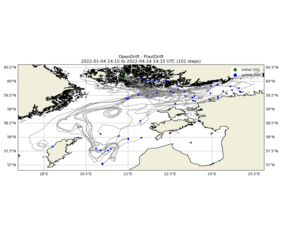Days are getting warmer, there is more daylight and the sea temperature is slightly getting higher - that is, it is not anymore just around zero. As a result of this, the sea ice is getting thinner in the south west corner of Finland in the Archipelago sea. The right term is “rotten ice”, which means that you should stay away from it, the ice fishing trips in this area are passé for this winter. And indeed, our 50 cigarette butts have obeyed the instructions of the Coast Guard and Rescue services and are distancing themselves from the rotten ice. But in their case the damage is already done, they have fallen into the sea, where they are attracting hungry fish ans seabirds, while disintegrating into smaller and smaller pieces of microplastics...
As our latest update demonstrates, the cigarette butts seem to have been bitten by the travel bug during these spring days. Restless souls have places to be. Some are still hanging around in the Archipelago sea, but there is a breakaway group that is heading to south. These butts have already reached the sea area between the Island of Gotland, which belongs to Sweden, and the Latvian coast. One has come ashore close to city of Visby, the main city on Gotland, whereas a few seem to be moving towards Gulf of Riga. A larger section of cigarette butts, on the other hand, seems to be heading to east, to Gulf of Finland. Some of them have already passed Tallinn, Estonia, and the busy ferry route between Helsinki and Tallinn. The port of Helsinki, as it happens, is one of the busiest passenger ports in the world, thanks to the ferry route to Tallinn and Stockholm. In 2019 it was the busiest, with 12 million passengers. And where there is humans, there is bound to be smokers. Hopefully those travelers, who decide to enjoy their ferry trip between these two capitals on the deck - and have a cigarette while they are there - dispose of their cigarettes in a sensible way and don't throw them overboard...
But we digress, so let's get back to our butts. It seems that we might have to zoom out, when we put the butts under the microscope in May, in order to fit all them on the same map. As the butts keep on spreading to different directions, to south/west and to east, the distance between them increases. The distance between the western and easternmost butt is already close to 500 km! What a journey for little butts!

